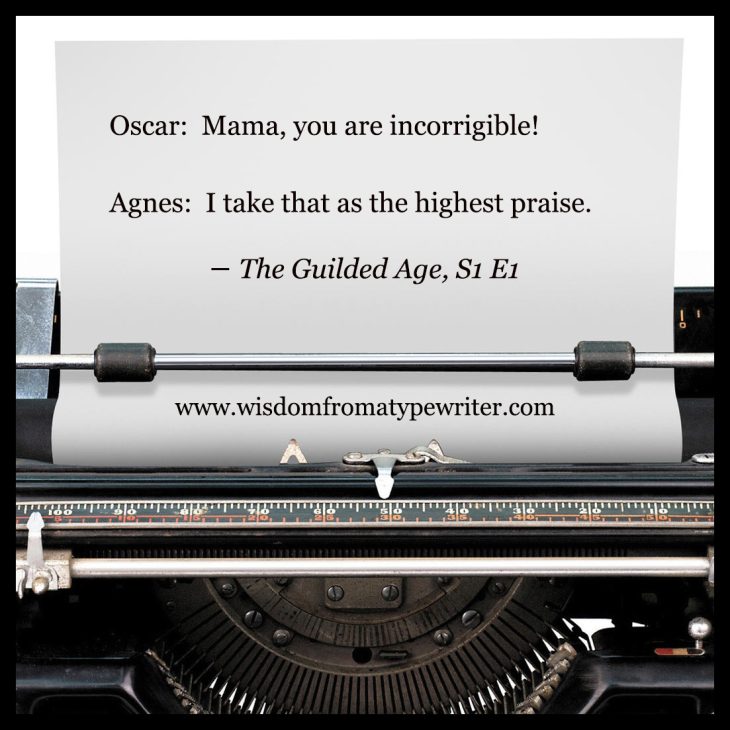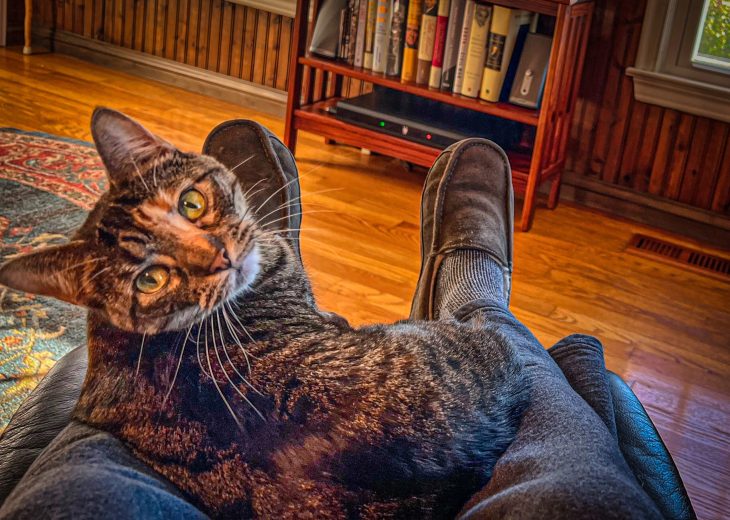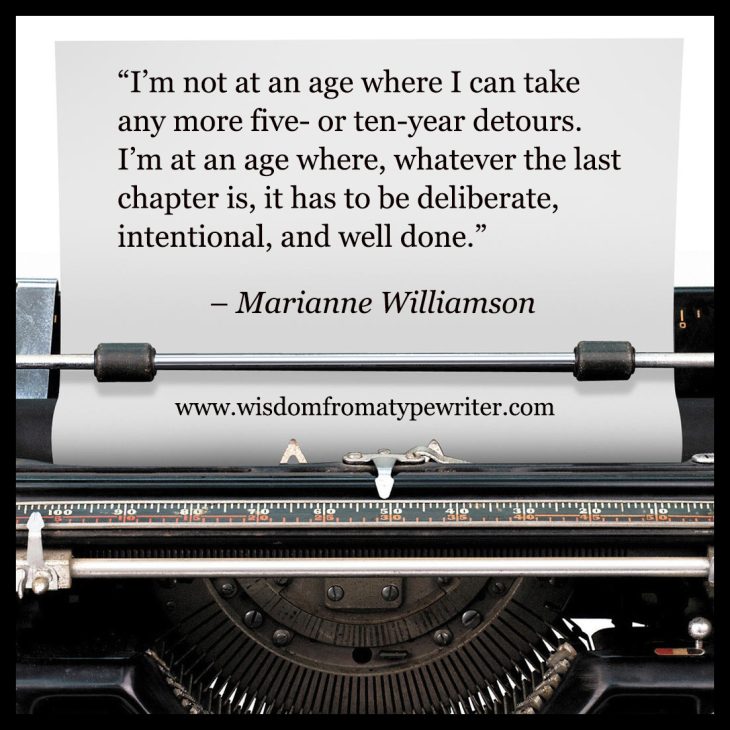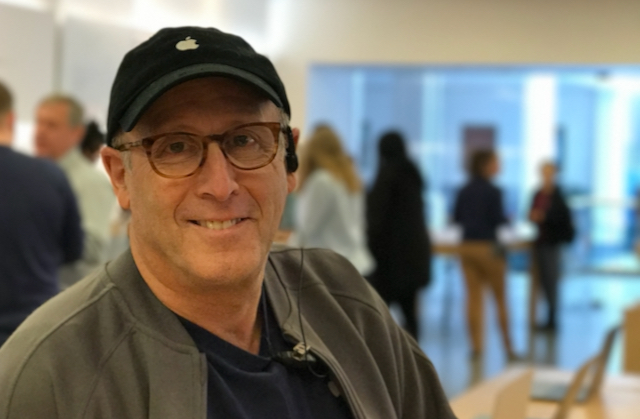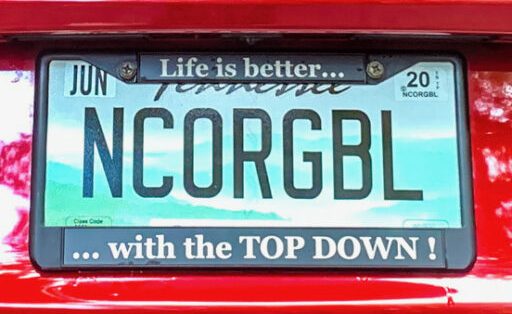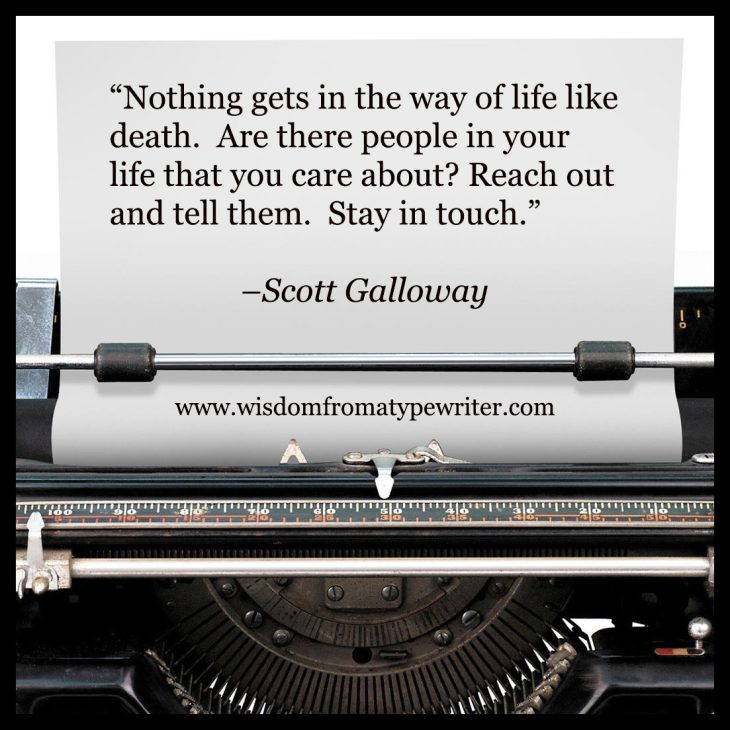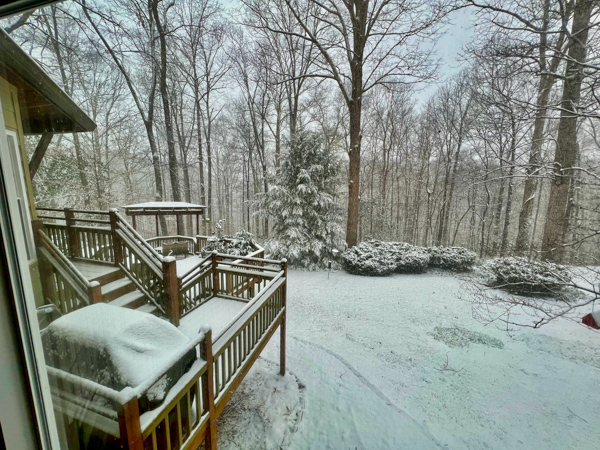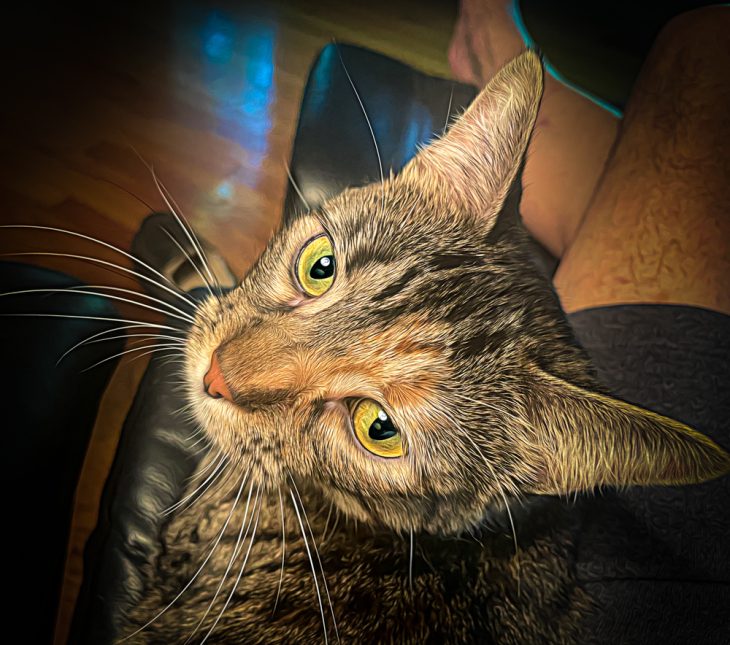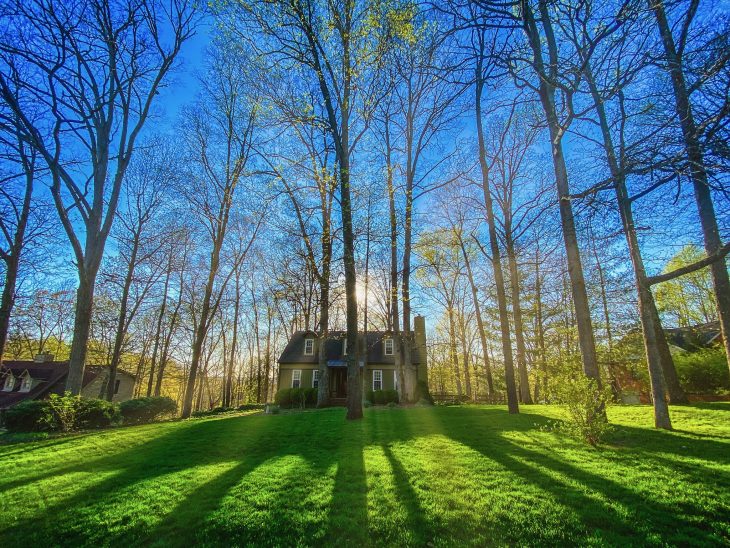I watched the first episode of HBO’s new show “The Gilded Age” last night. I’m not sure yet what I think of it. It’s created by the same guy who created Downton Abbey, and I liked that, but one episode in this seems over the top and a bit fatuous. I took a shine to Carrie Coon after The Leftovers and Fargo, but she seems wasted here in a role that is all about living in a ridiculously large house and wearing ridiculous dresses. Granted this was the pilot episode, so maybe it gets more worthwhile from here, but the viewing was at least hearing this line. I take a note these days whenever I see or hear the word “incorrigible.” Every time somebody uses that word, this little demon gets his smile on 😈
Author - Paul Schatzkin
… Why aren’t you at work??
*
Marianne Williamson is the only presidential candidate that has made it to a national TeeVee debate stage that I ever had lunch with.
That was back about 1990, when she was just getting started on the lecture circuit, talking about A Course in Miracles. Long before “A Return to Love,” Oprah, or the 2020 Democratic Party primaries.
At the time I met her, I was in Los Angeles training for my brief career (1990-1991) as a Series 7 securities peddler. I heard Marianne at one of her lectures at a church in West Los Angeles, talking about how she was  financially insecure, so I approached her after the lecture and we arranged a lunch meeting. Nothing came of it beyond that, other than the recollection that that was one of the most intense lunch meetings I ever had.
financially insecure, so I approached her after the lecture and we arranged a lunch meeting. Nothing came of it beyond that, other than the recollection that that was one of the most intense lunch meetings I ever had.
If nothing else, she and I are both Truman Babies (she 1952, me 1950).
This quote above is lifted from a profile in a recent edition of the New York Times.
Above: a portrait of the Silicon Slinger in Happier Times – ca. February, 2017
*
Long story short: on January 20, 2022, I was “terminated” from my job as a part-time product specialist for Apple, Inc. – after working for more than five years at their retail outlet in the Green Hills Mall in Nashville, TN.
As the story that follows details, I was fired for the grievous, cardinal sin of… asking a customer for her phone number.
… I’m finally owning it.
This is who/what I have been since the first time I got sent to the principal’s office.
For drawing a ‘naked stick figure’ of my third grade teacher, Miss Gaul.
Who, in hindsight, probably had no business being protrayed as naked in any context.
But what did I know, I was only 8 years old.
And already incorrigible.
Scott Galloway is a tech investor, commentator and business school professor at NYU.
I first learned of his existence on the Bill Maher show back in March, 2021. He made quite an impression. Maybe too strong an impression to ever be invited back.
But after I saw him on the TeeVee, I started listening to Pivot, the podcast he hosts with tech/business journalist par excellence Kara Swisher. They have as good a grasp of the Forces At Work in the World today as anybody.
Near the end of their first episode of the New Year, Galloway started talking about having lost a cousin to Covid. The cousin was all of 62 years old. In what almost amounted to a ‘hidden track’ at the end of the episode, Galloway said what I have quoted above.
And that, I hope, will be my mantra for the coming months.
Please say hello if you want to be among my “Dunbar’s Number”
It’s been a minute…
Happy New Year?
 We’re having quite the “winter precipitation” event here in Middle Tennessee today. It started snowing just as I was getting out of bed around 7AM… oops, no walk through the neighborhood this morning. If I don’t get out later, today could be the first time in a couple of years that I don’t “close the rings” in my Apple Watch fitness apps.
We’re having quite the “winter precipitation” event here in Middle Tennessee today. It started snowing just as I was getting out of bed around 7AM… oops, no walk through the neighborhood this morning. If I don’t get out later, today could be the first time in a couple of years that I don’t “close the rings” in my Apple Watch fitness apps.
What is it about a ‘snow day’ that invites the mind to wander? Is it just the notion that ‘nobody is going anywhere for a couple of days…’ that tempts us to back away from the usual sense of duty and obligation and consider other possibilities? That’s how I’m feeling at the moment. There is nothing I really have to do so… what would I like to do.
And it seems that the first place I turned is the open “Post” window for this website that I’ve been casually maintaining for what seems like a decade now.
Also: perhaps not coincidentally, today is the first anniversary of the “High Water Mark of the Conlunacy.” – apparently the last essay of any consequence I posted here.
Furthermore: I turned 71 while y’all weren’t looking, so all the miracles contemplated when I turned 70 remain germane.
I went on a road trip in late October/early November. From Nashville to Quebec Canada with stops in Gettysburg PA (for the battlefield) and Cooperstown NY (for the Baseball Hall of Fame) on the way up, and stops in West Hartford CT and Philadelphia PA (for family) on the way back. I nailed the timing, the foliage pretty much looked like this the entire time:

Shenandoah Valley, VA
Of course I took lots of photos along the way, but, also of course, I haven’t quite figured out what to do with them. Maybe I’ll just post some at random over the weeks or months ahead. Or maybe not.
Then it dawns on me, I can put the images on the web in a “shared album” via the Apple Photos app. Wanna see where I went? I’ll have to come back over the weeks ahead and tell the stories that go with the pictures.
 An any event, Buster was certainly glad to see me when I got home. She is sitting wedged between my thigh and the arm of the chair I’m sitting in as I type, but here she is when I got home from the trip back in November. She likes to ride around the house perched on my shoulder.
An any event, Buster was certainly glad to see me when I got home. She is sitting wedged between my thigh and the arm of the chair I’m sitting in as I type, but here she is when I got home from the trip back in November. She likes to ride around the house perched on my shoulder.
I know, I haven’t been doing the Daily Busters, I haven’t been doing the occasional “Wisdom From A Typewriter,” hell, I haven’t been doing much online at all – mostly because back in June I got my sorry ass off of Facebook and Instagram, which is where I posted all that stuff.
Now I guess I have to find some… strategy?… for posting stuff here with some regularity. Such are the sorts of thoughts that never make it past the “vague intention” phase of their formulation – and beg for some attention in the midst of a ‘snow day.’
In the meantime, I have assembled all The Daily Busters in a shared Photos album you can view on the Web via iCloud.
*
Having fully retreated from the toxic swamp of “social” media for the past six-plus months has altered my sense of ‘connection’ with the rest of the world – in ways that I am still hard pressed to make sense of.
On the one hand I rather miss the occasional – if ‘virtual – contact with people I care about.
On the other hand, I totally do not miss the obsessive ‘poke and scroll’ impulse or the subconscious desire for validation and gratification by inherent in “Like”s and comments. And I sure don’t miss being a peasant on Zuckerberg’s estate, tiling his digital fields for free while all the wealth goes to the Lord in his castle.
That’s about as much sense of the detachment as I can make for the moment.
In the months – years – prior to my “Zuckerberg Extraction”, I would often comment that I felt about Facebook (in particular) the way I felt about Scotch and vodka in the months/years before I finally stopped drinking. That was 34 years ago this past Thanksgiving. I wonder now, what was I like in that first year of sobriety? I think there may be parallels to what I’m feeling / experiencing now re: social media withdrawal. I don’t miss the reality of it so much as maybe I miss the idea of it, and even that passes with time.
But, still… what about the people I care about?
Who are they?
How do I stay in touch with them?
Do they want to stay in touch with me??
These are tougher questions to answer absent the casual association through the artificial mediation of something like Facebook.
But maybe I know where this is going, if I can muster the energy, focus, determination and consistency to get it there.
This vaguely forming concept of “analog social media” started during my road trip. I actually wrote and mailed a few postcards to people that I otherwise would have taken for granted would see my posts on Facebook. It was a much smaller potential audience, but as my friend Susan said when she got hers, “Postcards. What a great invention do you think they will catch on?”
Why the hell not?
So, I dunno, over the months ahead, I may pare down my bloated contacts database, find the 150 or so people I really want to keep in my life, and start sending them postcards – even if I’m not going anywhere.
Who knows, maybe some of them will send one back.
Well, she’s not on Facebook or Instagram, that’s for darn sure.
Because I deactivated both of those accounts about six weeks ago.
I probably need to write some kind of essay about why I finally pulled the plug on those accounts (deactivated but not deleted), how the “poke-and-scroll” impulse was making me nutz, how the past year of pandemic-induced solitude had magnified that impulse at the same time it reset my internal clock, etc. etc.
It’s complicated, but I have to say that I really do feel a whole lot more coherent without those nagging temptations, and I don’t really miss the illusion of “social” contact at all.
Too many times over the past year, I have described my use of Facebook (in particular, social media in general) the same way that I felt about vodka and Scotch in the last couple of years before I quit drinking (in November of 1987; 34 years if I’m still breathing come Thanksgiving).
Now I have gone ‘cold turkey’ and that experience echoes: when I first quit drinking and started going to AA meetings, I told myself “I’ll give this 30 days…” At 30 days, I figured I could go 60, and somewhere between 60 and 90 days I became DDFL – your Designated Driver For Life.
It’s been about two months since I shut those accounts down, and it feels like it did between 60-90 days when I quit drinking – like I could be a social-media avoiding lifer.
If I had any ambition left, I would be making some kind of concerted effort to round up those Facebook friends that I really want to stay in touch with and encourage them to sign up for the “Weekly Digest” that I set up for this site years ago. Maybe I’ll get to that yet.
In the meantime, the one thing I did with any consistency over the past year was post frequent photos of my Covid Kitty, the gender-neutrally named female cat called “Buster.”
Some people who have asked about my Facebook disappearance tell me they miss the #DailyBuster (even tough the posts were not exactly daily). I haven’t made a lot of new pictures of her over the past couple of months, but I did make one this past Sunday, so… there it is, atop this post.
If you want more, sign up for the Digest. Maybe I’ll rename it “The Daily Buster” – regardless of the frequency, and keep posting picture of the cat here from time to time.
The Post-Covid Recollections of a Closet Dodgers Fan
“The one constant through all the years has been baseball. America has rolled by like an army of steamrollers. It has been erased like a blackboard, rebuilt and erased again. But baseball has marked the time. This field, this game: it’s a part of our past. It reminds of us of all that once was good and it could be again.”
— James Earl Jones as Terence Mann in Field of Dreams (1989)
– – –
I went to Atlanta last week to see a baseball game, the first major league game I’ve been to in at least a dozen years. I went to see the Los Angeles Dodgers play the Atlanta Braves.
My attire for the occasion was conflicted: I wore a white Dodgers home-team jersey emblazoned with the number ’39’ – and a Braves cap. Other fans, many with the good sense to be wearing Braves jerseys and caps, inquired about my divided loyalties.
“I’ve been a Braves fan since I lived in Hawaii in the 1980s” I explained, “and Ted Turner’s cable station was the only live television we had out there. That’s when I first tuned in to the Braves. But I’ve been a Dodgers fan since I was 10. And that’s all because of that number 39…”
My trip to Atlanta for this afternoon of divided loyalties was, in some ways, a consequence of the pandemic. Call it “a gift of Covid.”
I’m still sorting out the impact of the bizarre year now past, how 14-plus months of nearly total isolation has slowed down my inner rhythms and rekindled dormant interests. I spent a lot of my involuntary solitude reading real books. And, curiously, a lot of those books were about baseball.
As the pandemic relaxes its grip and a new season of baseball chases the arc of the sun from spring into summer, I find myself interested in the game again, in a way I had not been for several years.
Of all the major sports, baseball is the only one I have ever had any real affinity for – perhaps because it was the only sport I played in school that I had any ability for, even though it wasn’t much. I never could run and bounce a ball, stop and throw it in a hoop. And given my 98-pound-weakling physique I had no business playing football at all. Though I was never picked first for anybody’s team, I could swing a bat and occasionally hit the ball, and I recall at least one dazzling play in the infield that got me thinking I had a future as a second baseman – at least until I tried and failed to turn a double play.
My interest in baseball faded over the past several years. Maybe because of the way computers and the internet have rewired my brain, I lost patience for the game’s languid pace. And once I got a TiVo, I l could no longer sit through the commercials.
I’d try to get interested in the playoffs and World Series, but those games are interminable. Glorious and brilliant as the essential game may be – as much as 90-feet between the bases and three-outs-per-inning are evidence of Divine Inspiration – four-plus hours is just entirely too much baseball, especially when most of that time is filled with endlessly repeating ads for trucks and nachos.
When the pandemic started and I found myself #HomeAlone, I started reading books about baseball. I started with W.P. Kinsella’s Shoeless Joe – the book that inspired the movie Field of Dreams. Then I read The Last Boy, a biography of Mickey Mantle. After that I plunged into David Halberstam’s epic account of the season that concluded with the Cardinals facing the Yankees in the World Series in October, 1964. Then I read a Phillip Roth book pretentiously entitled The Great American Novel which was, naturally, a satire about baseball.
All this reading seems to have rendered two clear, positive benefits. First, with nothing but time on my hands I rediscovered the simple pleasure of reading actual books, focusing on printed words and turning actual pages. And I think that re-rewired my brain in way that, coming out of the pandemic, I have also rediscovered baseball.
*
I grew up in the New Jersey suburbs of New York. We were Yankee fans. My father was raised in Manhattan, and the Yankees were New York’s team. The Dodgers? They were the less worthy denizens of the remote cultural backwater known as Brooklyn.
Some of my earliest memories revolve around baseball. Like that time I asked my older brother Arthur, “How long is an inning?”
“Three outs,” he informed me.
“Yeah but how long does that take?” I pestered.
“As long as it takes,” he insisted.
That was how I learned that there is no clock in baseball.
Other baseball memories include sitting on the bus after school one sunny October day and listening to the 7th game of the 1960 World Series – when Bill Mazeroski of the Pittsburgh Pirates hit the home run in the bottom of the 9th inning that ended the series – and Casey Stengel’s long tenure as the Yankees colorful manager.
The following year Mickey Mantle and Roger Maris went after Babe Ruth’s single-season home run record, and we tracked their progress on a bulletin board in my 5th grade class room.
Sometime in the mid-50s, my father took Arthur to a game at Yankee Stadium, and brought home a ball that had been autographed by a pantheon of 1950s icons like Mickey Mantle, Whitey Ford and Yogi Berra. Like idiots, though, we used that ball to actually play baseball in the backyard, and lost it in the weeds. I imagine that ball would be worth quite a few shekels today.
Unlike my brother – and all those talking heads in the Ken Burns Baseball documentary series – I never went to a baseball game with my father. My mother said once that he died just as I was getting to the age where he’d started doing things with me. Had he lived a little longer, maybe that would have included going to Yankee games.
The only game I do recall going to as a kid, my grandfather took me and Arthur to. It was the annual pre-season Yankees – Dodgers exhibition game, which had been a tradition in the years when those teams – and the Giants – made New York what Ken Burns called, “The Capital of Baseball.” That year, the Dodgers had to come from the other side of the country rather than from the neighboring borough of Brooklyn – since they’d moved to Los Angeles a few years earlier.
We were seated somewhere along the first baseline, at field level. I remember being astonished at how high a fly ball could go: on the TV, they just disappeared from the frame before falling into the fielder’s glove. In real life, they just keep going up and up and up until they’re just another tiny white dot in the night sky. To this day when I go to a ball game and somebody hits a towering pop fly, I am amazed at how high they go – once again an 8 year old is following the upward trajectory and wondering if it will ever come down.
Maybe because that first real baseball game was between the Yankees and the Dodgers, I have always felt that the best outcome to any baseball season is a Yankees-Dodgers World Series – like that Series in 1977 when Reggie Jackson hit all those home runs.
When the Yankees and the Dodgers play, I don’t really care who wins. I can cheer for every seeing-eye single, every dazzling catch in the outfield and every split-second double play. I can simply dwell in the explosive, athletic artistry of baseball. The Dodgers scored? Great. A Yankee struck out with two outs and the bases loaded? That’s great too. Just keep throwing, hitting, running and catching. Baseball is the only game that can transcend any moment and ride the relentless, infinite crest of its history.
That was our baseball heritage, to the extent we had any; we were New Yorkers living in New Jersey, and our team was the Yankees. The Brooklyns were a lesser breed who had abandoned the grungy city and moved to some sunny place called California.
But there is another reason why I could root for the Dodgers and/or the Yankees, why I was always a ‘closet’ Dodgers fan.
Because in the 4th grade I read a biography of a Brooklyn Dodgers catcher named Roy Campanella.
*
I don’t recall how that book first fell into my hands back in 1960, and until I re-read it along with the other baseball books I read during the Pandemic Summer, I really didn’t remember much of the actual story. I’d forgotten that the man’s name was ‘Campanella’ because his father was a white Italian immigrant who had married a black woman from Philadelphia. That one drop of Negro blood was all it took for Roy to be regarded as 100% black, and consigned to the Negro Leagues for much of his baseball career.
What I do recall vividly – some 60 years since I first read it – is that that book opened my eyes to the truth of America that they weren’t teaching us about at the Forrestdale School. From that book I learned about racial discrimination and inequality in the country that my all-white suburban elementary school taught me was the land of the free, where “all men are created equal.” From Roy Campanella’s story, I learned that there was – literally – a dark side to the “liberty and justice for all” that we pledged allegiance to every day when we stood with our hands over our hearts and saluted the flag.
And I learned from that book how a white man named Branch Rickey took a giant stride toward alleviating centuries of injustice by sending a black man named Jackie Robinson onto a grassy green field in the heart of Brooklyn to play a child’s game with white men.
Even in the 4th grade I knew, if vaguely, that Jackie Robinson was the first Negro to play Major League baseball. Robinson’s name is now enshrined not only in the annals of baseball history, but in the annals of American history as well. His number 42 is retired from all the teams in both the major and minor leagues, and every April 15 is Jackie Robinson day, when every player on every team wears that revered number 42.
Everybody remembers who came first.
But I remember the man who came second*.
Now batting for the Brooklyn Dodgers, three times the National League’s Most Valuable Player and eight times an All-Star, the catcher, number 39: Roy Campanella.
Campy could have been first. He had played in the Negro Leagues in the 1930s and 40s, and was signed to the Dodgers farm system 1946, the same year as Jackie Robinson. But when it came to finally breaking the color barrier that the Major Leagues had quietly enforced since the 1880s, Mr. Rickey chose the grittier Robinson to face – and face down – the taunts of opposing teammates and fans. Campanella made it to ‘the show’ the following year, after Robinson had proven that black players were just as deserving as any white player and carried the Dodgers to the 1947 World Series – where, of course, they lost to the damn Yankees.
Roy Campanella posted a lifetime batting average of 276, knocked in nearly a thousand RBIs, hit 242 home runs (putting him at #11 on the catchers lifetime homers list), was elected to the Hall of Fame in 1969 and according to legend was one of the happiest players whoever put on a uniform and glove.
All that came to a screeching, glass-and-bone-shattering end for Roy Campanella one frigid night in the winter of 1958, when his Chevy sedan skidded on a patch of ice, hit a telephone pole and flipped over. This was well before seatbelts were required in all cars, and the accident tossed Campanella around in the front seat, breaking his neck and leaving him paralyzed from the shoulders down.
His biography describes how Campanella almost gave up on life, but gradually came to accept his condition and rehabilitate some of the use of his arms and hands. He remained confined to a wheel chair for the rest of his life, but I was mightily impressed with the way the Dodgers organization took care of him. When the team moved west before the 1958 season, they took Campanella with them and kept him on as a coach. Over the following four decades he remained one of the most revered members of the Dodgers staff.
*
I lived in Los Angeles twice, first in the 1970s, and again for two years in the early 1990s. I went to a game at Dodger Stadium in the spring of spring of 1993. I don’t remember anything about the actual game – who the Dodgers played, any spectacular hits or plays in the field, or who won.
All I remember is one moment after the game.
I was on my way out of the stadium when I looked up the concourse and saw him: in his wheelchair, wearing a dark blue suit and a smile, waiting for an elevator, only a few yards away, in the flesh: the 71-year-old Roy Campanella.
I wanted to approach him. I wanted to say something to him. I wanted to thank him – for being alive, for living such a magnificent life, for overcoming his injuries and disabilities and remaining an inspiration.
But…
I whiffed it.
I let the moment pass, and regretted that choice the instant I’d left the stadium.
A few weeks later I regretted that decision even more, when came the news that Roy Campanella was finally well and truly safe at home: he died in June, 1993.
This spring, after re-reading that biography I had first read in the 4th grade and a small trove of other books about baseball, I am interested again in the one game that has been a constant through all the years, the only thing about America that has survived all the steamrollers and blackboard erasures. And in these moments of rediscovery I’ve done something that had never occurred to me to do before: I bought a baseball jersey. I found a website where I could get a vintage Dodgers jersey with whatever number I wanted, and I sent off almost $200 for a jersey with the number 39.

“B” is for “Brooklyn”
Along with the Dodgers jersey, I bought a bright blue cap emblazoned with the white letter “B” that the Dodgers wore for all those years they were the heart and soul of Brooklyn. I wear that hat often, and it is heartening when somebody stops and asks me what that “B” is for.
“No, it’s not for Boston,” I usually have to start out. “It’s for Brooklyn. Surely you know the Dodgers played there long before they moved to L.A., right? And do you know about Roy Campanella? No? Then let me tell you…” and off I go with how this man’s half-forgotten story opened my eyes to the underlying truth of American mythology – and made me a life-long Dodgers fan.
Every one of those conversations ends with an account of that day on the concourse at Dodger Stadium, seeing Roy Campanella in his wheel chair, waiting for an elevator and how I wish I’d said something.
I suppose I have a lot of regrets in life. It would be ludicrous to think that I could spend 70 years stumbling around on this planet without compiling a considerable list. Girlfriends come and gone, a couple of marriages (but no kids), opportunities squandered, friends and fortunes made and lost.
Nor can I think of even a handful of people who, over the course of those seven decades, have truly changed my life. But countless times over the years I have told the story of the book that I read when I was in the 4th grade, and of the ebullient black baseball player whose story wrapped itself around the heart of a ten year old white boy.
That afternoon on the concourse at Dodger Stadium, I had my opportunity to close the circle – and I let it get away from me.
I understand myself and my country better because of him, but in that moment I just couldn’t think of how to say, simply, “thank you” to number 39, Roy Campanella – the second* Negro to play baseball in the Major Leagues.
– – – –

Braves cap, Dodgers Jersey – and Guy Tucker, a kindergarten classmate who lives in Atlanta. We connected via Facebook but had not actually seen each other since about the time that photo of “The Little Yankee” (above) was taken.
– – – –
*OK, here’s a correction for all you purists and historians: it has come to my attention that, in fact, Roy Campanella was not the second Negro / Black / African American to play in the Major Leagues. That distinction belongs to Larry Doby, who went to bat for the Cleveland Indians on July 5, 1947, a little more than two months after Jackie Robinson made his debut with the Brooklyn Dodgers. That made Doby the first black player in the American League, and makes Roy Campanella the third black player in either league (and second on the Dodgers).
The point of this story is that ‘nobody ever remembers who came second.’ I’m leaving the text as written, but will add, ‘…or third’ to set the record straight.
(or: How I spent My WinterSpring SummerFall Vacation).
(This post is a revision of an earlier opus posted to coincide with the actual anniversary of the pandemic/quarantine. That version was more than 4,500 words. Shortly after I posted it I learned that the Nashville writers collective The Porch is compiling an anthology about the plague year, with a maximum word count for submissions of 3,000 words. So I cut and revised, submitted what follows on March 25, 2021, and still await a verdict re: acceptance or rejection. In the meantime, the guidelines say that posting to my own blog is ‘fair game.’)
*
1. Winter: #HomeAlone
March 13, 2021 marked a full year of the condition I’ve recorded in my journals and social media posts as “#HomeAlone.” I guess that was #HomeAlone Day 366 – since 2020 was a leap year.
Maybe it’s enough to say that a full year into the pandemic, I am still among the living. There are now more than two-and-a-half million Covid victims around the world who cannot say the same.
We have lived through a full cycle of seasons with Covid. It started in the winter of 2020, tore through the spring, the summer and the fall, and now here we are in the spring of 2021. Even with the vaccines, it could be a another full cycle before we can return to whatever passed for ‘normal’ before the virulent little bug first appeared.

Everybody on stage for the finale: Dave Olney tribute/memorial at the Belcourt – March 9, 2020
The last public event I attended was a tribute concert for the iconic singer/songwriter David Olney (Spotify link) – who died suddenly after collapsing on a stage in Florida in January, 2020. As friends and fans gathered the evening of Monday, March 9 at the Belcourt Theater in Nashville, there was casual recognition that something ominous was in the air, but it had yet to dawn on anyone that this might be the last concert we would attend for more than a year.
I worked my part-time job – peddling gizmos for a tech retailer – at the mall in Green Hills on Tuesday March 10 and Wednesday March 11 – which was the day the World Health Organization declared that the novel Corona virus had become a Global Pandemic. My customer interactions that day were normal, but I second-guessed myself after shaking hands a couple of times. By the end of the second day, co-workers and I had resorted to hand waves and fist bumps.
The next two days I was not scheduled to work. I watched too much TeeVee news, read too many online accounts, and tried to make sense of the invisible asteroid that was about to smash into the planet. I tried to separate useful information from the bubbling brew of hysteria. And I wondered how I was going to explain to my employer that because I was born while Harry S Truman was president, I am in the “high-risk-for-mortality” age bracket – and maybe I shouldn’t be coming into work for a while?
The day before my next scheduled shift, I called the store and said, “I’m a little concerned about coming to work today.” A few hours later the woman who runs the whole operation called back and said, “OK, we will take you off the schedule – and find someway to keep you on the payroll until you can come back.”
As I told my therapist at the time, that was such a moment of unexpected and unconditional support that it nearly brought me to tears. Actually, strike the “nearly.”
The next day my company closed all of its more than 300 stores in the U.S. and sent tens of thousands of employees home. The whole world went into panic mode and started running out of toilet paper.
And I started using the hashtag #HomeAlone. I’ll stop using it when I return to work in the store.
2. Spring: Expanding Waistline
I had started using a grocery delivery service a couple of months earlier; Once I entered the “I’m not leaving the house” zone, I came to rely even more heavily on such services.
Knowing the risks they were taking, I tipped the drivers generously. And I imagine I was quite the comic vision in bright yellow rubber gloves, washing and rinsing all the packages in the kitchen sink before putting them in the cupboards.
Thankfully, I already had more than enough toilet paper for the one person in the house who needs it once a day, but I might have started over-stocking on certain other staples. The freezer in my basement is still provisioned with a six-month supply of frozen proteins, and I still get weekly deliveries of fresh milk, orange juice, and eggs. And Oreos. Oreos have become my Quarantine Comfort food. I’m quite certain that I have single-handedly kept Nabisco in business for the past year.
It’s only a slight exaggeration to say that I really didn’t do much for the first few months besides eat. What I did do was get fat on Wheat Thins and cheese in the afternoons and a honkin’ bowl of Purity Cookies and Cream that I scarfed down with some late-night comedy around 10 o’clock every evening. From March to July I went from 173 pounds and jeans that were already a bit tight in the waist to 184 pounds – and the next size larger jeans.
Once it became apparent that nobody was going anywhere to do anything for months to come, the commentaries in my daily newsfeed ran the gamut from “don’t feel guilty about not doing anything during a pandemic!” to “use this time to do all the projects you’ve been putting off!” I did a bit of both.

Harvey Schatzkin & Ellen Gould, ca. 1943
On the ‘get busy!’ front, I played my guitar some, and returned to a project that has been lurking on the back burner for a couple of years.
I have in my basement a scrapbook stuffed with all of the letters that my parents exchanged in 1943 – the year between when they met and when they were married in January of 1944.
Most of that time future-father Harvey was deployed to a weather station in Greenland (you’d be surprised how vital weather information from the arctic circle was to the aviation war effort in Europe); Future mother Ellen stayed home in St. Louis, and they exchanged the sort of letters that war-time love stories are made of.
A while back, I’d started reading those letters, using voice-recognition software to transcribe them into digital text. Now with nothing but time on my hands I returned to that undertaking, reading and dictating several of the letters every day.

Harvey and Ellen’s letters, aka “The Pile.”
I am drawn to the letters in part because I never really knew my father. He died from cancer in 1958, at the age of 37; I was only 7 at the time – the age, my mother said later, when he was just starting to do things with me – like the night in October, 1957 when he took me out to see if we could find Sputnik wandering among the stars.
From his letters, I can tell that my father was a man of humor and depth – and was, uncommonly, passionately devoted to the woman he would marry and father three children with. Thanks to Covid and the afternoons spent combing through those letters, I have over the past year spent more time ‘in the presence of my father’ than I did in the few years when were both alive.
3. Summer: Life Is Better With The Top Down
As the months wore on, my part-time job went through numerous work-at-home iterations. To its credit, while millions were being fired or furloughed, my employer kept everybody on the payroll. But there really wasn’t a whole lot for us to do.
For the first few months, we did a lot of video conferencing, studying online manuals and guides to keep our knowledge and skills sharp in the event we returned to the store.
The store tried to reopen in the spring and called us all in for some “socially distanced” sales training.
It was weird driving into town for the first time in months, though it did occur to me that one upside of a global pandemic is the relative absence of traffic. It had been so long since I’d been to work, I had to consciously remind myself of the route that I take from my home in Pegram to the Mall in Green Hills: “Oh yeah, I get off the Interstate here… I turn here… wait, where the hell is everybody? Oh, look, plenty of places to park.”
Walking into the the Mall, I got my first taste of who was or was not wearing a mask – and I discovered how irritated I get whenever I see somebody with a mask that doesn’t cover their nose. I’m writing this nine months later and that still pisses me off – but I have learned to stifle my irritation – if barely.
With Covid case numbers still rising, the reopening date was postponed once… twice. When it was postponed the third time, they didn’t even bother to reschedule. The store stayed closed all summer and well into the fall.
In July, the company sent us specially configured computers so that we could join the online-and-telephone sales force. I am now a telemarketer.
I am genuinely grateful for the benefits my company has continued to provide – like health insurance (even though I am old enough to qualify for Medicare), weekly Covid tests and generous discounts on all the gizmos that I have come to rely on even more heavily in all these months of digitally-mediated isolation.
And I must admit that that those bi-weekly pay checks provide an essential buffer between daily deliveries from Amazon and having to compete with the cat for food.
When my shifts ended early enough – especially after Daylight Savings kicked in – I amused myself with almost daily drives in my Mustang convertible along the curvy backroads of this part of Tennessee on the outskirts of Nashville that I like to call “West Bumfuque.”
When there isn’t much else going on in your daily life, there is a lot to be said for putting on a cap and sunglasses, putting the top down – and downshifting and stepping on the gas coming out of the backcountry curves while a carefully curated playlist throbs from the stereo.

They said I’d never find what I was looking for: a Mustang Convertible with 6-speed manual transmission. But there it is, even in the color I wanted: Ruby-Fucking-Red.
Since there are no passing lanes along my routes, my idea of an “an achievement” in those days was going the whole 15 or 20 mile route without getting stuck behind a slower car in front of me. Suffice it to say my average speed was well above the posted limits.
Every such excursion reminded me how fortunate I am to live in the country, and offered a new appreciation for the fresh-cut fragrance of a farm no matter how fast I drove past it. But I did wonder if the people I zoomed past noticed, perhaps saying to one another “there goes that crazy guy in the red Mustang again!” – and again, and again.
I remember how anxious I was the first time I had to stop for gas. One of the info-nuggets that circulated during the early Days of Covid was that the virus could be transmitted through physical surfaces like a gas-pump handle. I adopted the practice of carrying my yellow rubber gloves with me when I went to the gas station. I panicked slightly one time when I left the store after paying and opened the door with my bare left hand instead of my gloved right.
Maybe it’s just fatigue after nearly a year, but I am less reluctant now to enter public spaces – though I still prefer curb-side delivery. Recently I ran to a restaurant in town to pick up a take-out order. While I was there I observed a surprising number of people seated at tables – and wondered if there was a revolver on each table with a single bullet in the chamber.
4. Fall: The Social Dilemma
Like everybody else in the world, I have defaulted to a virtual reality. Almost all of my social interaction is through screens of one kind or another. My laptop and tablet are always on, relentlessly tempting me into the bottomless abyss of doomscrolling.
Even more so than before the pandemic, Facebook has knotted itself into the daily fabric of my life. Here in the Covid Bunker, Facebook offers the persistent illusion of social contact and stimulation – in its compulsive, simulated way, filling the vacuum that forms in the absence of a real world.
It’s hard to separate the good that Facebook sometimes does from its insidious side-effects.
On the one hand, through Facebook I recently recently struck up a correspondence with a dear friend from junior high school I hadn’t spoken to for several years. When she wondered about my near daily #HomeAlone posts, I informed her of my divorce two years ago. We’re in the same boat, so to speak – only 2,000 miles apart.
There is also a group page keeps me connected with my neighborhood out here in West Bumfuque. Early in the lockdown, when the grocery stores ran out of staples, one of those neighbors supplied with me a huge bottle of ketchup.
On the other hand, Facebook is a relentless distraction, never more than a mouse-click away, and the cultural impact of its pernicious surveillance model has been widely documented.
I feel the same way about Facebook that I felt about Scotch and vodka before I quit drinking – but I’ve been saying that for years. For now, though, social media is the easiest place to go when I feel the need to unload some snark and irony – or if I just want people to see that I really – literally! – haven’t gone anywhere.

My “Work-At-Home” Station
My work has gone entirely online. Three-and-a-half days each week, I take calls from people all over the country, usually telling them why they are not going to get the gizmo they want when they want it – and asking sarcastic, rhetorical questions like “you do know we’re in the middle of a global pandemic, don’t you?”
Back in October, after one particularly arduous shift, a woman I’d ‘swiped right’ with started sending me text messages, and I just wasn’t in the mood.
That’s when I put a name on the condition that defines my year.
I have been living in an “Isolation Feedback Loop.”
I am alone, and, yes, it gets lonely. Now leave me alone.
5: Redux: Winter and Spring – Again
Given my age, the case numbers and the unfathomable death toll over the past year, I don’t think it’s an exaggeration to say that staying healthy has been no mean feat. As fellow Boomer Fran Lebowitz put it it in a recent NPR interview, “I think I’ve been excellent at not getting Covid – because I have not gotten it.”
Staying alive has mostly meant staying #HomeAlone. It’s just me and my screens and Buster the Demon Cat, who showed up over Memorial Day weekend thanks to a (mostly) Facebook friend. See? There’s that whole Facebook conundrum again.
Buster is my constant companion, following me all over the house as I make my daily commutes from the bedroom to the kitchen to the office to the living room and back to the bedroom. Every morning begins with her nestled in my arms, nuzzling my chin and purring her little heart out while I type in my journal.
While friends and acquaintances have turned this year into a period of extraordinary output – writing books, writing and recording songs and posting an infinite stream of Facebook Lives and videos on YouTube – the only thing I have done with any consistency is make photos of Buster and put them on Instagram and Facebook. When my grandkids ask, “Grandpa, what did you do during the pandemic?” I’ll just say “I put cat pictures on the Internet.”
Oh, wait.. I don’t have any grandkids – even though I turned 70 back in November. I had a step-granddaughter for a while, but lost her in the divorce, too.
One upside of all this solitude was rediscovering extended, linear concentration in the form of an ancient information technology called “books” – which I read sitting on my deck, watching the sunset while hummingbirds hovered at the feeders overhead.
Honestly, it hasn’t been all solitude and screens. I’ve had a few lunches with friends – outside, on sunny autumn days. I’ve gone for hikes in the park. I have spoken with neighbors that I hadn’t spoken to since the divorce (“I got the house but she got the neighbors…”). And, speaking of my domicile, I see my housekeeper every other Tuesday. I can’t imagine the squalor I’d be living in were it not for her.
But I can count the total number of hugs I have had since March, 2020 on the fingers of one hand.

From peak-to-trough, minus 30+ lbs
At the end of July, my Wheat-Thins-and-Ice-Cream-Quarantine-Diet peaked the scale at almost 185 lbs, and even the expanded-waist jeans I was wearing were starting to bind. That’s when I decided to try a regimen “Interim Fasting” that I learned about – where else but? – on Facebook. In my case, “fasting” mostly means I stopped eating those honking bowls of ice-cream every night at 10:30.
I walk four to six miles around my neighborhood every day, repeating the route so often that I’m surprised there is no rut in the pavement. I use an app to count my calories, and on March 4 I hit my goal weight of 155 lbs – the first time my weight has had a “150-handle” since I was in my 20s.
As March, 2021 draws to a close, I am – thanks to my advanced age and, at last, a competent Federal government – fully vaccinated.
As the prospect of a return to some semblance of normalcy shines over the horizon, I am beginning to detect the visceral changes that this year has imposed. I seem to be going through the world very differently. Maybe spending an hour or two nearly every day just walking at three miles an hour has rewired my internal wheel-works. Maybe that explains why I have found new comfort in books and words on paper and less patience for words on screens.
A few weeks ago, some prophet scrawled on a New York subway wall that “after the plague came the Renaissance.” There is good reason now to shed the gloom of the past year and begin to imagine the world reborn – the bright light that will shine upon us as we emerge from this long, dark tunnel.
When the pandemic is over, I’ll be able to say that I survived. I hung out with my dead parents. I put cat pictures on the Internet. I kept my job and learned new skills. I lost 30 pounds. And I read more books in a year than I read in the five years prior.
I didn’t get sick, and I didn’t die.
Now, where are my shades?

The words of the prophets are written on the subway walls…

